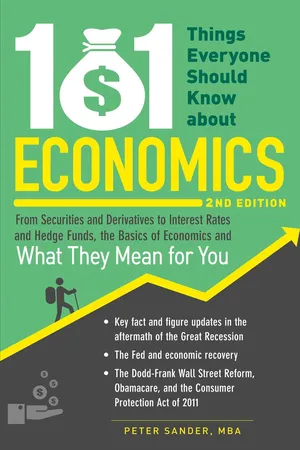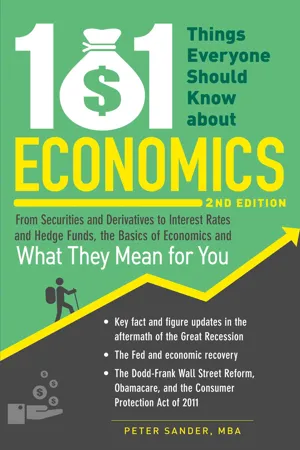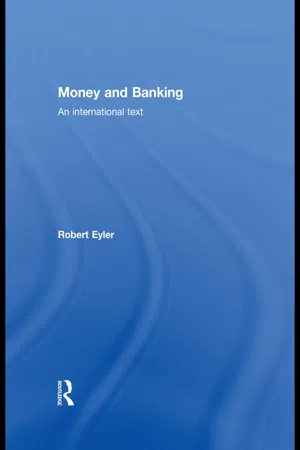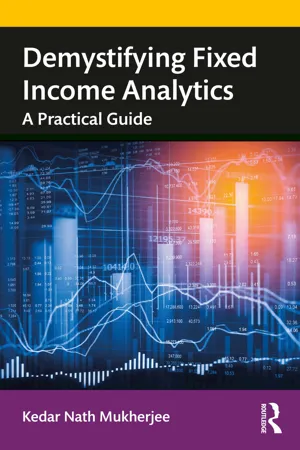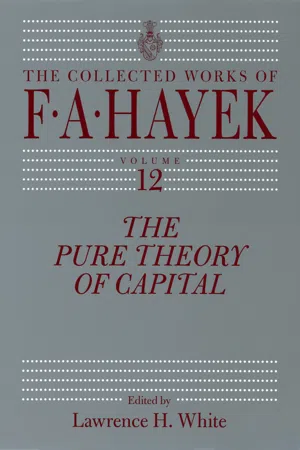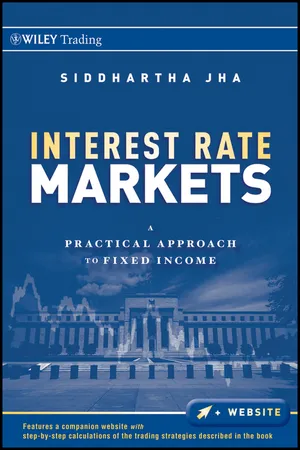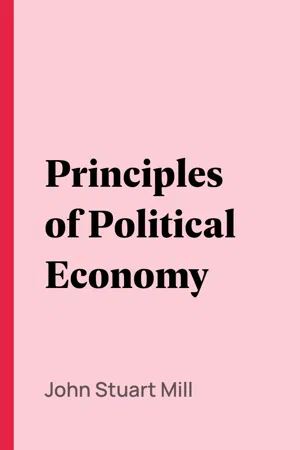Economics
Interest Rates
Interest rates refer to the cost of borrowing money or the return on investment. They are determined by the supply and demand for money in the financial markets and are influenced by central bank policies. Changes in interest rates can impact consumer spending, business investment, and overall economic growth.
Written by Perlego with AI-assistance
Related key terms
11 Key excerpts on "Interest Rates"
- eBook - ePub
101 Things Everyone Should Know About Economics
From Securities and Derivatives to Interest Rates and Hedge Funds, the Basics of Economics and What They Mean for You
- Peter Sander(Author)
- 2013(Publication Date)
- Adams Media(Publisher)
The good news: the sort of stagflation caused by regulation or economic inefficiencies is less likely to happen in the United States than elsewhere. Despite what it may seem like sometimes, the U.S. economy is considered to have one of the easiest and most consistent regulatory climates of any developed country. This is why many economists are concerned when they hear cries for more regulation, and why they became concerned with some of the proposed policy changes that came with the recent economic crisis—they want to preserve the “stable state” the United States offers for capitalist commerce.21. Interest Rates
An interest rate is the price a borrower pays to borrow money. The key word is price —for whatever reason, possibly owing to the negative references to the borrowing and lending of money in the Bible, the concept that interest is a price paid for the use of something, in this case, money, is poorly understood by most. If you think of Interest Rates as a price, sometimes too high, sometimes a bargain, you’ll learn to make better decisions when evaluating a borrowing opportunity.From your point of view, Interest Rates are a price, or cost, of using money. They are also the price, or benefit received, for letting someone else use your money, as in when you deposit money in a bank or buy a bond. Finally, on a national scale, Interest Rates are also a vital tool used by governments to control money supply and the availability of credit, and thus to exert some control over the economy.What You Should Know
Interest Rates are normally expressed as a percentage of a borrowed balance over the period of one year. Many Interest Rates are quoted as a nominal, or ongoing, interest rate, with an “annualized percentage rate” quoted in parallel to account for all borrowing costs, including fees, associated with a borrowing transaction, on an annual basis. Federal law requires publication of APRs to allow simple “apples-to-apples” comparisons of the price to borrow money.The interest rate, or price, for the use of borrowed funds depends on several factors:- Length of loan term. How long will you keep the money you borrow? That will influence the price, because of two things. First is the opportunity foregone by the owner of the money to spend it or invest it in something else. People tend to prefer liquidity
- eBook - ePub
101 Things Everyone Should Know About Economics
A Down and Dirty Guide to Everything from Securities and Derivatives to Interest Rates and Hedge Funds - And What They Mean For You
- Peter Sander(Author)
- 2009(Publication Date)
- Adams Media(Publisher)
For the U.S. consumer, the sort of stagflation caused by oil shocks or similar shortages creates the most concern. If you see inflation in the economy, particularly energy and food prices, that should not be taken as signs of a robust economy; more likely, the economy will sink as higher prices sap the strength, like a tax, of the economy. If the government tries to deal with these effects by tightening the money supply, look out, especially if you’re in an economically sensitive vocation.The good news: the sort of stagflation caused by regulation or economic inefficiencies is less likely to happen in the United States than elsewhere. Despite what it may seem like sometimes, the U.S. economy is considered to have one of the easiest and most consistent regulatory climates of any developed country. This is why many economists are concerned when they hear cries for more regulation, and examine some of the policy changes and reversals that came with the recent economic crisis—they want to preserve the “stable state” the United States offers for capitalist commerce.21. Interest RatesAn interest rate is the price a borrower pays to borrow money. The key word is price—for whatever reason, possibly owing to the negative references to the borrowing and lending of money in the Bible—the concept that interest is a price paid for the use of something, in this case, money, is poorly understood by most. If you think of Interest Rates as a price, sometimes too high, sometimes a bargain, you’ll learn to make better decisions when evaluating a borrowing opportunity.From your point of view, Interest Rates are a price, or cost, of using money. They are also the price, or benefit received, for letting someone else use your money, as in when you deposit money in a bank or buy a bond. Finally, on a national scale, Interest Rates are also a vital tool used by governments to control money supply and the availability of credit, and thus to exert some control over the economy.What You Should KnowInterest Rates are normally expressed as a percentage of a borrowed balance over the period of one year. Many Interest Rates are quoted as a nominal, or ongoing interest rate, with an “annualized percentage rate” quoted in parallel to account for all - eBook - ePub
Money and Banking
An International Text
- Robert Eyler(Author)
- 2009(Publication Date)
- Routledge(Publisher)
Something we will explore in depth when we talk about money demand later is the idea of the interest rate as the opportunity cost of having cash in your pocket. This relationship between the quantity of cash or liquidity demanded and the interest rate is of key importance to a great deal of macroeconomic theories but also to monetary and fiscal policy in practice. The way consumers react to changes in Interest Rates paid on their cash holdings changes the demand for goods and services, as well as the demand for lending. However, for now the idea is simple: the interest rate is the opportunity cost of holding money in your wallet rather than in an interest-bearing account or investment.Measure of time preference
It is this definition that links the three above and binds them in the household’s eyes. When you chose to consume more than your income, or consume with credit rather than paying in full, you are making a choice about your time preference to consume. The interest rate is a measure of how people prefer to consume with respect to time: if the interest rate falls, there will be marginal changes in consumption based on a smaller cost of credit. Certain households which initially would save, say $1000, now spend $100 of that $1000 and save only $900. They still save a certain amount, but it is less. The lower interest rate has triggered an incentive for them to spend on credit, or prefer to spend now than later in time.The cost of borrowing falls in the previous example, providing an incentive to borrow. Certain lenders must provide the loan, thus they see the interest rate as the revenue from lending, and want to take advantage of it. Finally, the borrower must demand cash in order to spend, thus the cost of holding money must also be going down at the same time, and intuitively it does. The interest rate is all four of these ideas simultaneously, and must be for financial markets to work correctly. We will see later that the interest rate’s measure of time preference characteristic makes the entire economy work correctly. - eBook - ePub
Demystifying Fixed Income Analytics
A Practical Guide
- Kedar Nath Mukherjee(Author)
- 2020(Publication Date)
- Routledge India(Publisher)
The interest rate is the rate that is charged or paid for the use of money and is expressed as an annual percentage of the principal. From an investor’s perspective, the interest rate is the annual return which he/she generates from her/his investment. Interest rate can be of two types: nominal and real Interest Rates. Nominal Interest Rates are normally positive, but real Interest Rates can be negative, depending upon the economic situation, especially the rate of inflation. The interest rate may change because of several factors; such as: inflationary expectations, alternative investments, risk of investment, liquidity preference, tax implication, and most importantly the maturity or period. Depending upon the length of the period, Interest Rates could be short term (with less than one-year term) and long term (or a maturity above 1 year). In some cases, there could be some rates of medium term with a maturity between one to 5/10 years. Some important short-term rates are: interbank call rates of different maturity (LIBOR/MIBOR with 1-day, 1-month, 3-month, 6-month, 1-year); 1-day, 7-day, 14-day, 1-month repurchase (Repo) rates; 3-month, 6-month, 12-month deposit/lending rates, 91-day, 182-day, 364-day T-bill rates; short-term swap rates, etc. On the other hand, some of the long-term rates include: yield on long-term government securities, corporate bond yields, bank lending rates, long-term swap rates, etc.Some important Interest Rates in Indian debt marketBenchmark rateThe benchmark interest rate, alternatively known as base interest rate, is the minimum interest rate that investors will demand for their non-governmental investment, say a non-Treasury security. It is also tied to the yield to maturity offered on on-the-run (most recently issued) Treasury security of comparable-maturity. Alternatively, a benchmark rate is an interest rate against which other Interest Rates are calculated. For example, a benchmark rate could be the interest rate at which the central bank of an economy (here RBI) gives loans (borrows money) to (from) the commercial banks under their jurisdiction, which further can be used as a benchmark by the commercial banks to decide the interest rate for their loan or deposit products of different maturity. The interest rate at which commercial banks and other selected FIs can borrow (lend) money from (to) the Reserve Bank of India is called Repo Rate (Reverse Repo Rate), which is presently (as on December 2019) at 5.15% (4.90%). At the same time, the other benchmark rate, offered by the central bank, in India is the Marginal Standing Facility (MSF) Rate, and Bank Rate, which is presently (as on December 2019) at 5.40%. In the case of borrowing under Repo from RBI through the Liquidity Adjustment Facility - eBook - ePub
- F. A. Hayek, Lawrence H. White(Authors)
- 2011(Publication Date)
- University of Chicago Press(Publisher)
5 To every increase in the demand for one commodity (or other type of asset) there would correspond an exactly equal decrease in the demand for another kind of commodity. That is, prices would be determined in the same way as in the imaginary barter economy. And, in particular, the demand for investment goods would be exactly equal to that part of their assets which people did not want to have in the form of consumers’ goods. The supply of funds not spent on consumers’ goods would become equal to the demand for such funds at a rate of interest corresponding to the rate of profit as determined by the given prices. There would be differences between the rates of profit people expected to earn in their own businesses and the rates of interest at which they would be willing to lend and to borrow, corresponding to the different degrees of risk. But the net rate of interest would tend to be equal to the net rate of profit. And the relative prices of the various types of goods, and therefore the price differences, would depend solely on the relation of the proportions in which people distributed their money expenditure between consumers’ goods and capital goods to the proportions in which these two types of goods were available.Influence of Monetary Changes on Rate of InterestWhile this would undoubtedly be the position once equilibrium had been established, it is one of the oldest facts known to economic theory that changes in the quantity of money, or changes in its ‘velocity of circulation’ (or the ‘demand for money’), will deflect the rate of interest from this equilibrium position and may keep it for considerable periods above or below the figure determined by the real factors. This fact has scarcely ever been denied by economists, and since the time of Richard Cantillon and David Hume6 it has been the subject of theoretical analysis which has been further developed in more recent times,7 particularly by Knut Wicksell and his followers.8 But it has also given rise to a recurrent scientific fashion, from John Law9 down to L. A. Hahn10 and J. M. Keynes, of regarding the rate of interest as being solely dependent on the quantity of money and the varying desires of people to keep certain balances of money in hand.We - eBook - ePub
- Jagdish Handa(Author)
- 2002(Publication Date)
- Routledge(Publisher)
part sevenTHE RATES OF INTEREST IN THE ECONOMYPassage contains an image
chaptertwentyTHE MACROECONOMIC THEORY OF THE RATE OF INTERESTThe rate of interest is one of the endogenous variables in the Keynesian and classical models, so that its analysis is properly conducted as part of a complete version of those models. These were presented in Chapters 13 and 14.This chapter singles out the competing views on the determination of the rate of interest and focuses on their differences and validity. It also highlights the very important difference between the comparative static and the dynamic determination of the rate of interest.key concepts introduced in this chapter
• The Fisher equation of the nominal rate of interest• Stocks versus flows of funds• The loanable funds theory• The liquidity preference theory• The excess demand function for bonds• The dynamics of interest rate determination• The neutrality of money and inflation for the real rate of interestMacroeconomics avoids the bewildering array of Interest Rates on the numerous assets in the market by focusing on one single rate of interest, without completely specifying which rate of interest it is, as for example in the IS-LM model of Chapters 13 and 14 - eBook - ePub
Interest Rate Markets
A Practical Approach to Fixed Income
- Siddhartha Jha(Author)
- 2011(Publication Date)
- Wiley(Publisher)
For the equilibrium level of Interest Rates, one has to consider the participants across all fixed income markets. This is because the supply and demand for funds is not segregated to particular markets—for example, if the Fed purchases all existing mortgages, banks will be forced to move some of their holdings to the Treasury market by buying in the secondary market. Consider, however, a situation where all the issuance in the fixed income space is in the corporate market. Also assume that total demand for fixed income is at $5 trillion but that corporates will issue $10 trillion. To digest this supply, some Treasury bonds will have to be sold and funds diverted to the corporate market. As the supply is too large to digest, yields will have to rise until they are attractive for investors. Treasury yields will likely rise, as the selling of Treasuries to buy corporates will pressure yields higher, as will the need to compete with higher corporate bond yields. To be sure, corporate yields will likely rise more than Treasury yields; nonetheless, since the overall size of supply is much larger than aggregate demand, rates overall need to rise to clear the market. Thus, to understand Interest Rates, investors need to have a good handle on the supply/demand picture of both the Treasury market and the overall fixed income market.Although these points are long-term factors affecting supply and demand for funds in an economy, for a horizon of months to a few years, the economic cycle has a strong effect on both sides of the supply/demand balance for funds as well. Any discussion of the interplay between the economic cycle and Interest Rates is incomplete without considering the role of the central bank. To regulate the swings in the economy stemming from the business cycle and the leverage cycle, the central bank controls short-term Interest Rates and has other tools, as discussed in Chapter 3. The central bank acts as the independent authority to control money supply in most modern economies; in the United States, this central bank is known as the Federal Reserve. The interplay between growth and inflation among consumers, producers, and the government is a driving factor behind Interest Rates. In most advanced economies, the presence of a central bank adds another entity in the interplay of economic growth and inflation. The central bank is meant to prevent rampant printing of money to fund government expenditures, which can lead to unchecked inflation. Beyond controlling money supply, the Federal Reserve acts as an external force to curtail volatility in the economic cycle and act as a lender of last resort in times of crisis. Although market economies allocate resources efficiently most of the time, at times they can encounter crises and periods of instability that can turn into vicious cycles. By intervening and providing support for financial markets, the Fed therefore serves an important purpose, and its actions have a major impact on all financial markets. To understand the interest rate cycles of the United States or other developed markets, we need to incorporate information from the economic cycle along with the likely reaction of the Federal Reserve to incoming economic data. The Fed's changes to short-term Interest Rates in response to the economic cycle affect the demand and supply for fixed income products across maturities, thus changing the level and shape of the yield curve. - eBook - ePub
- John Smithin(Author)
- 2008(Publication Date)
- Routledge(Publisher)
5 The determination of Interest RatesIntroduction
In the treatment of Interest Rates in macroeconomic and monetary analysis, there are three key issues that need to be discussed or debated before any other matters, such as what might be the “correct” interest rate policy, can usefully be raised. These are, first, the basic or essential nature of interest, and, specifically, whether or not it is purely a “monetary phenomenon”, as Keynes said, or simply the reflection of some other, supposedly more “real”, economic phenomenon. Second, the distinction between real (now in the sense of inflation-adjusted) Interest Rates and nominal Interest Rates. This is an entirely different issue from the first point, the confusion being due to the different senses in which the term “real” is used in economics. Third, the relationship between Interest Rates on securities with different terms to maturity, that is between “short” and “long” Interest Rates. The first three parts of this chapter therefore deal with each of these points in turn.There then follows a discussion of alternative theories of interest rate determination, implicitly of the determination of the inflation-adjusted interest rate. Writers such as Hicks (1989) and Smithin (1994, 2003a) have previously claimed that there are fundamentally three such theories, but it is now argued that it is more useful to think of four alternatives, the fourth (actually the most influential in orthodox circles) being a hybrid of two of the others. Finally, there must be some discussion of the controversial question of the ethics - eBook - ePub
Principles of Political Economy
Abridged with Critical, Bibliographical, and Explanatory Notes, and a Sketch of the History of Political Economy
- John Stuart Mill, J. Laurence (James Laurence) Laughlin, (Authors)
- 2009(Publication Date)
- Perlego(Publisher)
Chapter XIX. Of The Rate Of Interest.§ 1. The Rate of Interest depends on the Demand and Supply of Loans.
The two topics of Currency and Loans, though in themselves distinct, are so intimately blended in the phenomena of what is called the money market, that it is impossible to understand the one without the other, and in many minds the two subjects are mixed up in the most inextricable confusion.In the preceding book285 we defined the relation in which interest stands to profit. We found that the gross profit of capital might be distinguished into three parts, which are respectively the remuneration for risk, for trouble, and for the capital itself, and may be termed insurance, wages of superintendence, and interest. After making compensation for risk, that is, after covering the average losses to which capital is exposed either by the general circumstances of society or by the hazards of the particular employment, there remains a surplus, which partly goes to repay the owner of the capital for his abstinence, and partly the employer of it for his time and trouble. How much goes to the one and how much to the other is shown by the amount of the remuneration which, when the two functions are separated, the owner of capital can obtain from the employer for its use. This is evidently a question of demand and supply. Nor have demand and supply any different meaning or effect in this case from what they have in all others. The rate of interest will be such as to equalize the demand for loans with the supply [pg 441] - eBook - ePub
- David Reed(Author)
- 2008(Publication Date)
- AMACOM(Publisher)
The fed funds rate hit an historic low in 2001, when the rate actually hit 1.00 percent. Think of that for a moment: an interest rate of 1.00 percent. That was a time when the economy wasn’t doing all that well and the Fed wanted to help stimulate the economy by lowering the cost of money.By lowering the cost of money to a bank, the Fed can encourage that bank to make more loans—cheap money, right? Conversely, when the economy is overheating or has the potential to overheat with low unemployment numbers, high wages, and a solid GDP, the Fed will begin to increase short-term rates to discourage banks from making loans.Banks make loans to businesses so that they can hire more people or make more widgets, and the better business is, the more money companies might want to borrow.There is a constant ebb and flow in the money markets, and this is something you need to understand so that you can catch mortgage rates at the most opportune time—or at least get as close as you can.Economic Indicators
It’s important that you understand what will worry the Fed one way or the other. Essentially, if anything shows positive growth for the economy, then the Fed will be looking at raising the fed funds rate. While it rises by only ¼ to ½ percent at a time, this is still a significant increase in the cost of funds.Economic reports are released throughout the business month and there are a number of them, but the ones that have the most impact on Interest Rates are: Unemployment report Consumer Price Index (CPI) and Producer Price Index (PPI) Gross domestic product Factory orders Retail sales Consumer confidence Personal income and personal spending Chicago Purchasing Managers’ Index ProductivityUnemployment Reports
This report is one of the most influential economic reports released. It is released the first business Friday of each month, and it shows three key elements: The unemployment rate Nonfarm payroll WagesThe unemployment rate is stated as a percentage and is perhaps the most widely published number coming from this report. For instance, an unemployment rate of 5.565 percent would mean that of all the available workers in the United States—those who are either working or actively looking for work—5.565 percent are currently out of work but are looking for work. - eBook - ePub
- W. Charles Sawyer, Richard L. Sprinkle(Authors)
- 2020(Publication Date)
- Routledge(Publisher)
S o far, we have examined the institutional details of the foreign exchange market and explained what determines the exchange rate. The model of exchange rate determination developed in the previous chapter explains some of the movement in exchange rates. Both the rate of inflation and the growth rate of GDP usually do not change dramatically over short periods of time, such as one day to the next. Yet, exchange rates change almost every minute of every business day. As a result, we need to expand our model of exchange rate determination to include another factor that determines or influences exchange rate movements over short periods of time. This factor is short-term Interest Rates. Since Interest Rates have an important influence on the exchange rate, we need to describe what causes domestic Interest Rates to change. In the first part of the chapter, we will review and expand on what you learned in your Principles of Economics course concerning the supply and demand for money and the determination of the equilibrium interest rate within a domestic economy.In the second part of the chapter, we will examine the relationship between Interest Rates and the exchange rate. As we will see, any change in Interest Rates will lead to changes in the inflows and outflows of capital in a country’s financial account and the changes in capital flows lead to changes in the exchange rate. By the end of the chapter, we will be able to examine how changes in Interest Rates, the exchange rate, the current account, and the financial account all interact with one another.MONEY DEFINED: A REVIEWWhen trying to determine how money affects the exchange rate, our first objective is to define the term money. Most individuals believe that they know what money is, but in fact, what constitutes money is not clear at all. The easiest way to describe money is to consider what it does. Money has to perform three separate but important functions. First, it must act as a medium of exchange. This is money’s most important function. How would economic transactions be conducted in a world without money? Without money, every price would be a relative price. For example, the price of a hamburger would be defined as what a hamburger is worth in terms of all other goods and services. In an advanced economy with a large number of goods and services, this relative pricing quickly becomes untenable. The price of one hamburger might be defined as four soft drinks or .04 tires. No one could possibly keep track of all the possible relative prices. The power of money is largely dependent on solving this relative-price problem. If there are 50,000 goods in any economy, there are only 50,000 prices. This is complicated but the alternative is far more complicated. Even if governments did not produce money, some item would emerge as a medium of exchange. In anything other than the simplest economy, something would emerge to serve as money.1
Index pages curate the most relevant extracts from our library of academic textbooks. They’ve been created using an in-house natural language model (NLM), each adding context and meaning to key research topics.
